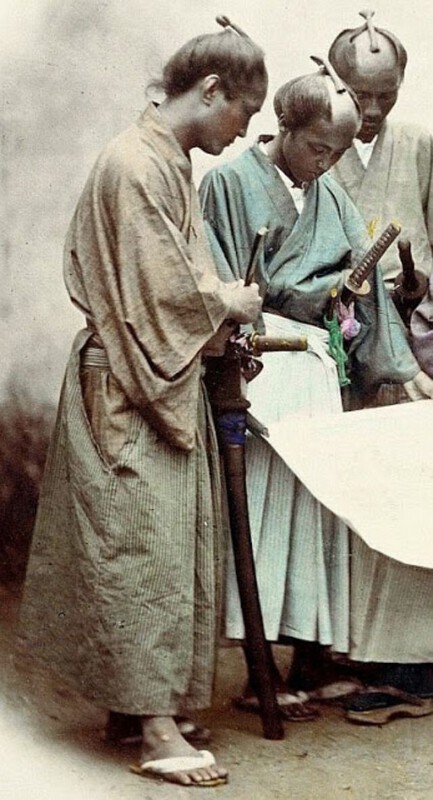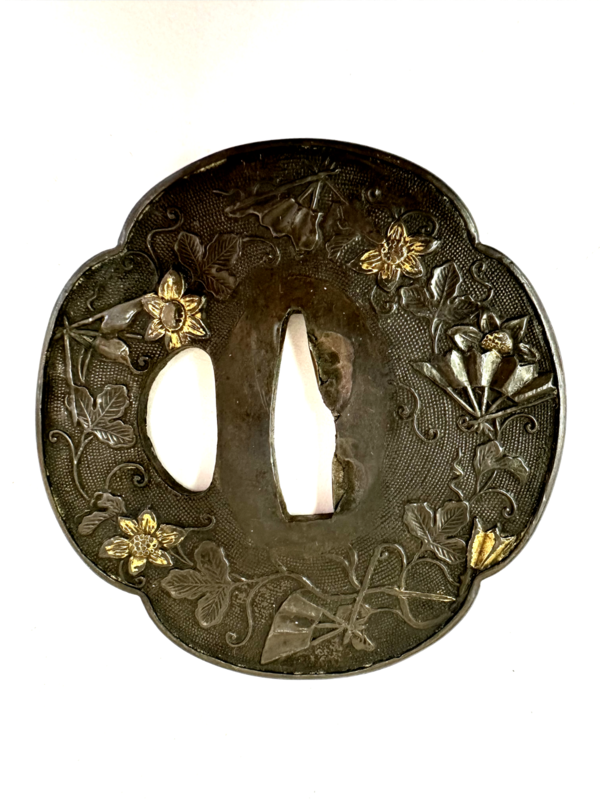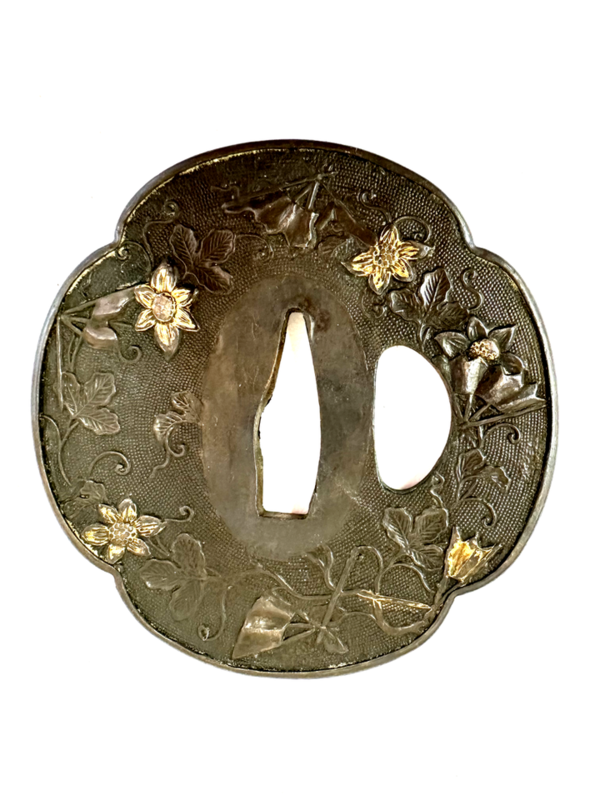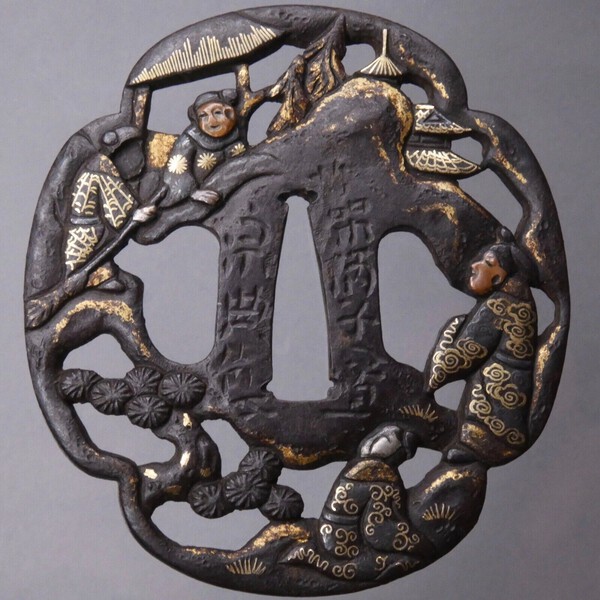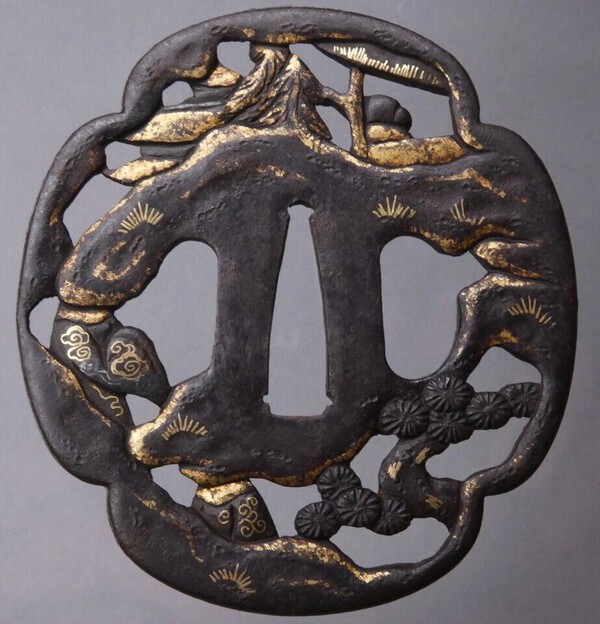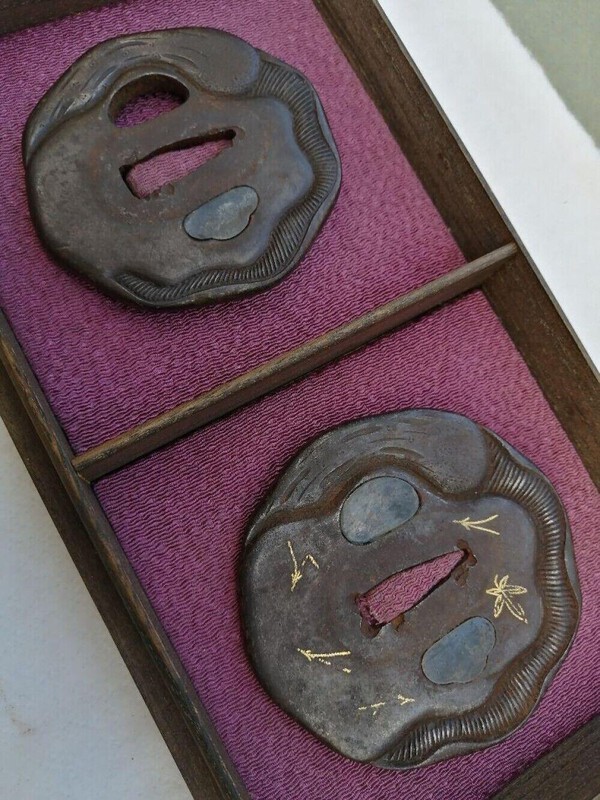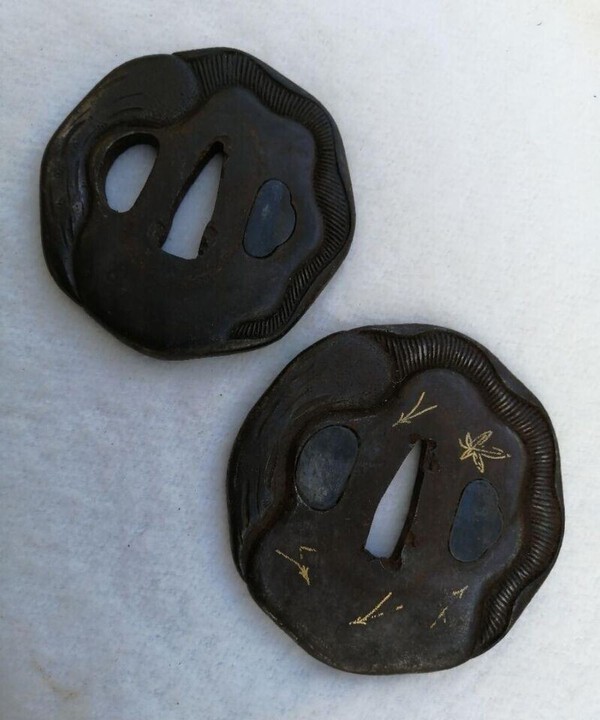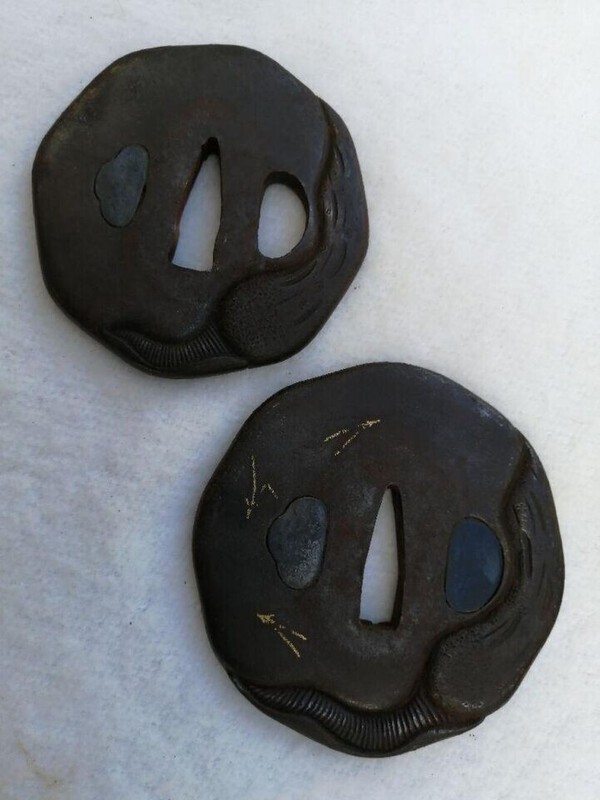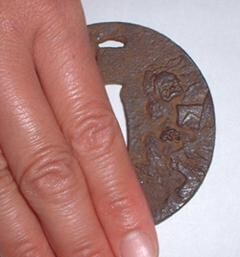
Dan tsuba
Members-
Posts
440 -
Joined
Content Type
Profiles
Forums
Events
Store
Downloads
Gallery
Everything posted by Dan tsuba
-
Thanks for that insight, my friend, stating "suggesting that some tsuba of this type at least were cast". Oh no! Here we go again! Just kidding!! With respect, Dan
-
Is that "manhole cover" type tsuba hand forged or cast!! Ha, ha, ha, ha, etc. Just having some fun! With respect, Dan
-
Yes, overcleaned by someone. But who cares! The last time I said something like that I was "jumped on" by a lot of so called tsuba "experts"!. But don't get me started on the negativity that this forum can create! I think your tsuba are nice tsuba to add to a collection for a new collector. Hell, I would like to add them to my collection! Someone has to give this type of tsuba a good home!!! Learn from them and appreciate them!! With respect, Dan
-
Thanks Thomas! You are correct. I zoomed in on the picture, and what is on top of the samurai’s head is perfectly tied hair! Also, thanks to Spartancrest for your post. I quote part of it here “Kanzashi came into wider use during the Edo period, when hairstyles became larger and more complicated, using a larger number of ornaments. Artisans began to produce more finely crafted products, including some hair ornaments that could be used as defensive weapons.” The picture you included in your post may just be how the kogai could have been used to hold the hair (with the added feature of a possible defensive weapon and an “ear scoop” on one end!!) ? The adventure continues! With respect, Dan
-
Thanks Thomas! Your post makes a lot of sense. Although the samurai on the left of the photo in my previous post seems to have his hair tied, the two other samurai on the right of the picture seem to have something on top of their head. I have included a picture of what I think that object is. It is also called a kogai (picture included below), although not the metal kogai that is also referred to as an "ear cleaning" (or whatever) tool and is shown in my above post. So, was the metal kogai an ear cleaning tool? Was it a hair arrangement tool? Was it used to thrust through the ear of a defeated opponent? Was it used as some sort of dull surgical tool to extract an embedded arrow? Was it used for eating food? Or did it have all these uses or some other unknown use? Who knows? Just some more interesting stuff! With respect, Dan
-
Hello all, So, I was finally able to afford and buy a kogai (pictures attached). Let’s talk about ear cleaning.! I put the “scoop” end in my ear. Yes, it probably could help in cleaning out an ear, but my pinkie finger goes further in my ear than the “scoop” end of the kogai! So why use the “scoop”? How about a hair arrangement implement. I don’t think so. It appears to be on the heavy side to be used for that function (it would fall out of the hair), and it is not like any Japanese kogai hair arrangement tool that I have seen on the websites (picture attached with samurai with kogai in their hair). So, what was it used for? I have seen pictures on this forum on the below thread- https://www.militaria.co.za/nmb/topic/25292-usability-of-kogai/ of Japanese woodblock prints showing subjects using the “long end” of the kogai in ear cleaning. But one “slip” in the cleaning process and the ear drum is damaged or ruptured! How about a dull surgical type tool? Maybe something that can be used to remove an arrow from the subject without cutting the area of the body with a sharp kogatana?? Is that a possibility? I just think that there was more to the kogai’s use than just maybe ear cleaning and possible hair grooming! With respect, Dan
-
-
I just received this (what I consider). a beautiful sanmai tsuba! Purchased from Japan for $63.00 U.S. (which included shipping!). It makes a great addition to the collection! Just wanted to share! Show me yours, and let's have some fun! With respect, Dan
-
Hello Thomas! I quote a part of your post- “Dan, You have not provided suffcient evidence to convince most people following this thread. The hunt continues.” Well, for me, the hunt is over. I am done with my research! Also, it must have taken you a very long time to contact most people following this thread and find out if they think I (and a few others) have not provided sufficient evidence to convince them that cast iron tsuba were made in the Edo period. Or was that statement just your opinion? With respect, Dan
-
Hello Tony. So, what exactly are you inferring by underlining “Works of iron” in the Shinsa Standards? Are you equating “works of iron” with only hand forged tsuba? If I am incorrect in what I think you stated I apologize, but I will go on. Some posts in this thread explain how cast iron could be re-heated, softened and hand worked. So, cast iron could be a “work of iron”. Have you read the entire thread? I have spent over 2 years on this thread and I am no longer interested in doing more research. I know that I (and a few other members) have provided enough research, evidence, and proof to show that cast iron tsuba were made in the Edo period. With respect, Dan
-
Hello all, So here is something of interest that I was advised by a friend to look at. It is the “Shinsa Standards: (amended by May 19, 2015)" and can be downloaded from the below weblink- https://nbthk-ab2.org/shinsa-standards/ The area under “Tosogu (Fittings) Hozon Tosogu” is of particular interest since it mentions cast fittings! The several numbered areas of that particular area of the article need to be read. Now, I interpret what was stated as cast iron, cast copper, and cast bronze tosogu! The adventure continues! With respect, Dan
-
Very nice tsuba, congratulations! Excuse my ignorance, though. So, the Tokubetsu Hozon Tosogu papers shown in the weblink with the included pictures of the tsuba on that certificate were issued to this tsuba? If I wanted to submit one of my tsuba for papers, does anyone have an idea on how much something like that would “set me back” in dollars? With respect, Dan
-
Hello all (again!). So, there I was again searching the internet. One thing led to another, and I got referred to some previous threads on this forum dealing with cast iron tsuba in the Edo period. Looking at those threads, it reminded me of how on a forum some very interesting threads (at least I think they were interesting - and yes- I contributed to those threads!) can get “lost” in the shuffle! I include those weblinks below for anyone that is interested. https://www.militaria.co.za/nmb/topic/43646-an-edo-period-cast-iron-tsuba/ https://www.militaria.co.za/nmb/topic/44471-edo-period-cast-tsuba/ The adventure continues! With respect, Dan
-
Hello all, So, once again, I was stumbling around on the internet! I found something interesting relating to the aoi leaves and cast iron(?) tsuba shown and mentioned in the above posts. It was found at the below weblink- https://babel.hathit...60/t0tr0c195&seq=166 It is a book about “Japanese sword-mounts; a descriptive catalogue of the collection of J. C. Hawkshaw... comp. and illustrated by Henri L. Joly,” published in 1910. From page 72 of that book- “830 - Iron;, two aoi leaves within a circular rim. Signed : Kinai of Echizen (? cast;). xix.”. I could not find the picture they were referring to (maybe I missed that?) So even in 1910 they were not sure if something was hand forged or cast iron as stated by the (? cast) in the above tsuba description of #830! And that was only 42 years after the end of the Edo period, so really not that long after the end of that period of Japanese history! Onward! With respect, Dan
-
So all, I find this of interest. I thought that tagane-ato could not be punched deep into a cast iron tsuba. When I saw deep punch marks on the seppa-dia of a tsuba I figured that it could not be made from cast iron, otherwise the cast iron would split and break (cast iron being very brittle). Well, I was wrong (once again!). Below are pictures of an obviously cast iron tsuba with fairly deep tagane-ato punch marks! So, maybe if the cast iron tsuba was properly annealed, deeper looking punch marks could have been made in the seppa-dai? Anyway, just a thought! Further, what is interesting about this somewhat "delicate looking motif" sukashi tsuba, is that there is no need for conducting noninvasive metallurgical testing to determine that this tsuba is definitely made from cast iron! The adventure continues, With respect, Dan
-
Hello all! So what would be the best "guess" (in Spartancrests post above) when these tsuba were made? Edo? Meijii? Can it actually be discerned? Who knows? Hand forged? Cast? What are the "tells" to look for? Can anyone actually know for sure without subjecting these pieces to noninvasive metallurgical testing? I can't wait for someone (I mean we are in the 21st century!) to develop an inexpensive way of testing these things. The question is why hasen't something like that been done yet? Even if something like that was available, maybe many individuals don't really want to know if a tsuba they purchased as hand forged could actually turn out to have been cast? With respect, Dan
-
Hello all! So, referring to a water kettle with a tsuba that I posted on October 15, 2023 (some pictures below). Obviously that tsuba is made from cast iron. Whether cast in the Edo period or not is impossible to determine. Probably the only way to deterimie if it was actually cast would be to subject it to non-invasive metallurgical testing. I purchased a similar tsuba that was pictured on that water kettle a couple of weeks ago (pictures also attached). That tsuba has a mei. There are a plethora of these similar motif tsuba being sold on various purchase sites. How is it possible to determine a hand forged from a cast iron one of these? I know that a mei can be “faked”, the tsuba could have been made after the Edo period and a “fake” mei from the Edo period added to that tsuba. Or the tsuba could have been made in the Edo period with no mei, and a “fake” mei added later. Or the tsuba and the mei can reflect the actual maker of the tsuba in the Edo period. Without taking a hammer to the piece and seeing if it is brittle and breaks (cast iron), how does anyone determine such things? I even have discovered that if a tsuba like this is papered by the NBTHK, it still can be very misleading. I have found that the old green papers can be incorrect and themselves could have been forged! Are we all just “floundering” around when it comes to the more inexpensive type of iron tsuba and just must take our chances? Who is right in their determination if a tsuba is hand forged and not cast? Who is wrong? I mean can a description of a tsuba being listed by a reputable seller be wrong? I know, maybe I am just overthinking this thing. But how can tsuba collectors be certain of anything with so many variables that turn up and present themselves? I mean is it possible that knowledgeable people could be incorrect in their determination? I have even heard were the NBTHK could make mistakes! Always with respect, Dan
-
Hello dependazelle! Welcome to this great forum! I don't know much, but your tsuba looks like it is a hand forged tsuba to me! Don't know anything about the mei. I am certain much more knowlegeable members than I am can tell you about it. Maybe place it on the "translation assistance" part of the forum? Oh yeah, you and I seem to have the same forum logos! That will be fun!! With respect, Dan
-
Hello all- So, I was looking at purchase sites the other day (my usual morning routine!) and a tsuba just “jumped out at me”! A few pictures and a summation of the write up from the site are shown below. Now, I can never prove it is cast iron (unless I bought it and took a hammer to it!). But (in my opinion) to my eyes, it looks cast! I arrived at that conclusion by looking at Soto school pieces in the Ashmolean Museum, The A. H. Church Collection of Japanese Sword-Guards (Tsuba) at the below link- http://jameelcentre....ection/7/10237/10366 On the tsuba shown below, the mei looks like it was cast. Also, the nakago-ana has those (more or less) horizontal looking type slots in the top and bottom of it. I find that those slots usually appear on cast iron tsuba, so the tagane-ato punch marks do not have to be put into the cast iron tsuba to place the sekigane into the nakago-ana (if sekigane was needed). If tagane-ato punch marks were to be put on a cast iron tsuba, the tsuba would probably (because there are other factors to consider) crack, split, and break! For me, those horizontal slots in the nakago-ana to hold the sekigane are a marker or tell that I use to help me determine if the tsuba could be possibly cast iron or is hand forged. The tsuba shown is even missing a copper face of a figure on the left hand of the tsuba (omote side). Is it possible that the tsuba craftsman of the time (possibly in the Edo period?) cast and hand worked these tsuba in an “assembly line” type fashion? The tsuba was cast, then it was filed, and then the artist painted some motif on with gold paint, and then glued the copper (or other types of metal) faces on the figures? If you look closely at the pictures, you can ascertain some unfiled areas of the tsuba (like around the chrysanthemums) and some areas that are slightly raised but were forgotten to have been painted (like on the sleeve and robe of the figure on the right of the tsuba). You can also see other areas of the tsuba that are undulating, not flat, and appear as casting flaws? Could this particular type of tsuba that is supposed to represent the Soten school have been cast and is not hand forged? Is it as old as the description below states (pre-1800 – personally, I don’t think so)? Was it only made for the tourist trade? Are there other examples “out there” but that have sekigane in the nakago-ana to show that they have been mounted? I know I have also seen other similar type (possibly Edo period?) cast iron tsuba on this forum and some are missing one or a few of the faces (as is this tsuba), and some are complete. Although I can’t recall which thread they were shown on! Was this tsuba made in the late Edo period (and I know that is a very difficult -if not impossible-thing to determine!)? If it is newer than the Edo period, it seems like a lot of work for a craftsman to go through just to make a fake Edo period tsuba, which probably could have been made after the Edo period with a lot less detail and work (then the one shown below) just to sell it to the tourists! And of course, I could be totally wrong about everthing I stated in this post (and I probably am - ha, ha, ha, etc!!) I just thought this particular tsuba is very interesting and presents several possible questions. The adventure continues! With respect, Dan Iron Tsuba Soten, signed made by Mogarashi Sōten, Primary Material - Iron Original/Reproduction - Antique Original Region of Origin - Japan Age- pre-1800 Disclaimer- I am not an expert, so look at the photographs carefully.
-
Hello Ron M, That is my kind of tsuba, old and rusted! I like it! Motif seems to be a pine tree in the mountains (maybe with water on the lower left), cloud and moon on the omote side. Then on the ura side. Same scene with pine tree and water. But there is a mountain shown on the upper right. Could be Mt. Fuji? I have a hard time discerning the moon on this side of the tsuba. There appears to be some sort of gold fleck on Mt. Fuji, but I don’t know what that is. Nice! With respect, Dan
-
Hello, new collectors! So, in my last post I displayed what I thought was a “good purchase” using the markers and tells I discussed in my previous posts. It appears that I received a “sad” emoji (personally, I think the whole “emoji” thing should be eliminated!!). So, is that member “sad” that I purchased what I consider a good purchase and they missed out on it?? Anyway, for whatever reason, some members on the forum seem to avoid me like the plague (or Covid 19)!! Don’t let that deter you from trying to make your own “bargain purchase” of tsuba by using some of the markers and tells that I have described in my previous posts! Remember, you can always ask for assistance from members of this forum. I am certain that they would be glad to help! And I consider this forum to be the world's best place to ask for assistance on tsuba . But hey, that is just my opinion!! So, you new collectors, go out there on those purchase sites and have some fun (within your spending budgets!). When in doubt, ask for help on this forum! With respect, Dan
-
So, for those new collectors of tsuba (on a limited budget, as I am!). Using some of the markers and tells described in my previous posts, I recently purchased the tsuba shown below. Cost (withdrawing the amount for free shipping from Japan and the wood box) about $85.00 U.S. per tsuba for this daisho set!! Bargains can still be had!!! With respect, Dan
-
Stephen, sir- Thank you for your opinion on what Darrel may have meant. Although I think that Darrel himself should clarify. Again, this is "off topic" here. I have re-visited the "Tsuba casting molds?" thread. I know, "oh no"!! With respect, Dan
-
Hello again! I decided to post more information here because of another thread that I started. That thread is- https://www.militaria.co.za/nmb/topic/47395-tsuba-purchasing-for-new-collectors/ There was a post by a member on the other thread which renewed my interest in this thread. If you refer to one of my previous posts on this thread, you will find out about a cast iron tsuba that I have. That post is on page 7 of this thread (Nov 17th, 2022). It shows and explains a tsuba in my collection. If you look close at the pictures (I have 2 of the same tsuba) you will notice that the tsuba (specifically on the tsuba shown on the right) has faint seppa marks on the seppa-dai (referring in my response here to something that was stated on the former thread listed). Now, what is also interesting is that on this thread on a post that is dated June 21st, 2023 (page 12), I have referred to a Japanese dealer’s website. That website is- cast iron (ksky.ne.jp) On that website you can see the exact same tsuba as mine and it is shown in pieces as a cast iron tsuba. (Pictures of my cast iron tsuba and the dealer’s broken cast iron tsuba are attached.) And on another one of my posts dated June 27th, 2023 (page 12), you can read where I contacted the dealer and they stated- “Yes, I agree with your opinion. All the cast iron tsuba look from Edo period for my eye. cast iron (ksky.ne.jp) Sincerely yours. Sumie Kashima, operator of Usagiya” So, there is something for your consideration! With respect, Dan
-
Oh no my friend Darrel!! I know this is off topic here, but you started it! I don't exactly know what you meant in your last post. Could you please give a clearer explanation? I am perfectly willing to continue the "Tsuba casting molds?" thread if that is what it takes! And I also know many members will say "oh no, not again"!! Ha, ha, ha, etc!! With respect, Dan



